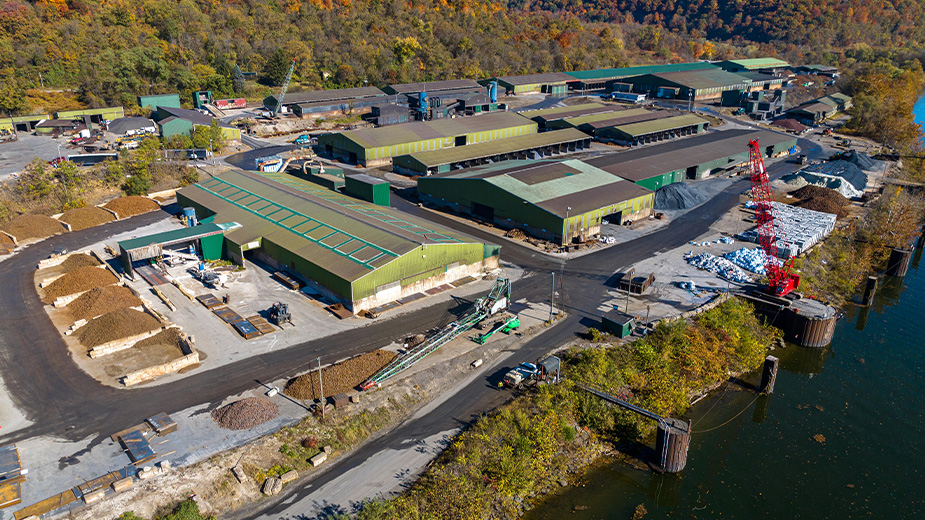Grants Provide Boost to Businesses, Community Projects
The 150-ton crane installed last year at S.H. Bell Co.’s East Liverpool terminal has a greater lifting capacity – 40 tons, as opposed to 25 – than the equipment it replaced, Rusty Davis says.
More importantly, it’s safer than that 1970s era crane, according to the retired vice president of operations for the company, now serving as a consultant at the facility. The operation handles a wide range of products, from items that weigh a metric ton to steel slabs that are up to 20 times that.
“It’s just an updated model that’s much safer,” he says. “It does have a better lifting capacity, so it allows us to handle a few additional products.”
It’s also a piece of equipment that Bell’s East Liverpool terminal might not have without the assistance of a program that the Columbiana County Port Authority accessed. The Ohio Department of Transportation’s maritime assistance grant program provided a $630,500 grant, about half the approximately $1.2 million crane’s cost.

The maritime grant program “is drawing attention to the river, which is obviously one of our biggest assets here in Columbiana County,” Brittany Smith, assistant executive director of the Columbiana County Port Authority, said.
“We probably wouldn’t have [the crane] today if it hadn’t been for the help from the port authority,” Davis says.
Such grants, offered at various levels of government or by private entities, are used to assist various businesses or community improvement projects. Some are structured to provide assistance to businesses broadly or are structured to address particular business sectors or segments, or to achieve specific objectives.
“We get a lot of calls for grants,” says Diane Richardson, assistant director of Lawrence County Economic Development Corp. in New Castle.
Among the grant programs Pennsylvania offers is the Redevelopment Assistance Capital Program, which “funds projects that have major impacts on areas,” Richardson says. Local recipients of RACP funds include Steelite International, which was awarded $3.5 million to support a warehouse expansion project, and Keystone Compliance, which received $1.5 million for its own expansion project.
In neighboring Mercer County, RACP funds are among the resources being used to support redevelopment of the former Carine & Co. warehouse in Sharon, near the Penn State University Shenango campus. The project, which will involve redevelopment of the building as a mixed-use property with recreational space and apartments, received $500,000 in RACP funds and $450,000 from the city of Sharon – out of the approximately $3.3 million the city allocated to businesses from its American Rescue Plan allocation – as well as a $400,000 state tax credit.
Jim Landino of JCL Development, which is redeveloping the Carine property with Hudson Companies in Hermitage, anticipates a June groundbreaking for the $2.8 million project. Contracts should go out for bid in the next 30 days, and construction should take about a year, he expects.
“Grant money for a town that’s in the revitalization mode is a lifesaver to get things going,” Landino said.
Landino, who has purchased and redeveloped several other properties in downtown Sharon, attested to the value of such programs to help fill funding gaps in projects. Early on in his real estate deals, he learned that once he purchased a building, he would “basically go into a deficit immediately.” The challenge is coming out of a project done to comply with codes and requirements such as under the Americans with Disabilities Act “with an appraised value that equals your investment,” he says.
“The banks are willing to lend money if the appraisals are there. The challenge we’ve had is getting appraised values high enough to support the financing required to do the projects. Without the grant money to basically bolt down the down payment that we’ve already made or that we will make on our own, there’s a gap between the ability to finance and the amount of capital needed to do the projects.”
Other RACP awards last year included $1 million for Joy Cone Baking Co.’s expansion, $850,000 for JCL Development’s Downton Sharon Center and $500,000 for repairs to a former Wheatland Tube building.
Last year was “probably one of our best years ever in terms of getting projects funded through the RACP program,” says Rod Wilt, executive director of Penn-Northwest Development Corp.
Pennsylvania also offers a rail freight assistance program. “Generally, that can fund 70% of a project to put in rail to a manufacturer, and other rail-related projects,” Richardson says.
In addition to the more than $3.3 million the city of Sharon has provided directly to businesses from its American Rescue Plan allocation for façade improvements and other projects, the city is using federal community development block grant funding for various initiatives, including website assistance and security cameras, Sherris Moreira, downtown director for the city, says. Much of this will be done through the newly formed Sharon Community Development Corp.
The city and nearby Hermitage also recently received Local Share Grant money through the Pennsylvania Race Horse Development and Gaming Act. Hermitage received $425,000 to construct a new animal shelter, and Sharon received $325,000 to go toward razing the former Huntington Bank building downtown and riverfront development at the site.
The cities of Youngstown and Warren each launched façade programs over the past year, funded by their share of American Rescue Plan funds. Warren, which made grants of up to $10,000 to more than 50 businesses with the $500,000 it put toward the program, earlier this month put the same amount of funding toward the second round.
Youngstown’s new façade program, which was established earlier this year and is being administered by Valley Partners, has $1 million available. The program has a $20,000 cap per business, and the city so far has approved six grants.
“In many cases, the grant funding was part of a larger project,” Melissa Phillips, executive director of Warren Redevelopment and Planning, said in a March 3 news release announcing the expanded funding for the façade program. “That’s important for people to know. Grant funds can supplement a broader improvement initiative.”
Other communities that operate façade grant programs include the city of New Castle, Richardson says.
Columbiana County can access grant funds though agencies such as the Appalachian Regional Commission and U.S. Department of Agriculture, CCPA’s Smith says. ARC funds were used to make energy efficiency improvements to a building in Leetonia, substantially reducing its utility costs.
Other grant programs to assist local businesses are in the works.
Valley Partners in Liberty Township, which administers Youngstown’s façade grant program, also is looking into one.
“I do have something else in the works, but nothing to report yet,” Teresa Miller, executive director, says. “We’re waiting to hear back from a funder.”
Launching some kind of grant program “is definitely something that we are looking into,” Julie Needs, executive director of the Sustainable Opportunity Development Center in Salem, said.
“We’ve been having some conversations about that. Our mayor is very interested in doing something, but nothing on the books as of yet,” she said.
Pictured at top: A crane sits on the barge cell at S.H. Bell Co.’s East Liverpool facility.
Copyright 2024 The Business Journal, Youngstown, Ohio.



